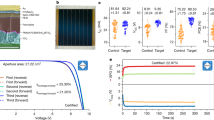Abstract
Anodic oxide films formed on aluminium in lower aliphatic carboxylic acids exhibit self-colouring of yellow through brown, and characteristic properties such as photoluminescence (PL), electroluminescence (EL), and electron spin resonance (ESR). These phenomena are closely associated with the carboxylate species incorporated in the oxide during anodization1. Although the presence of incorporated carboxylate species in some cases2,3 and their distribution in oxalic acid film have been established4, there have been little data available on the state of incorporated impurities in the oxide. We have studied the distributions of coloured material and PL centres in the oxide and report here that most of the coloured material is located in the outer region of the cell walls of an oxalic acid film, but that the PL centres are in the middle region and have different properties from those of the outer region. These results suggest that the incorporated impurities which are present in the various states in oxide have to be converted during anodization.
This is a preview of subscription content, access via your institution
Access options
Subscribe to this journal
Receive 51 print issues and online access
$199.00 per year
only $3.90 per issue
Buy this article
- Purchase on Springer Link
- Instant access to full article PDF
Prices may be subject to local taxes which are calculated during checkout
Similar content being viewed by others
References
Tajima, S. Electrochimica Acta 22, 995–1011 (1977).
Pullen, N. D. J. Electrodep. tech. Soc. 15, 69–74 (1939).
Tajima, S. in Advances in Corrosion Science and Techology Vol. 1 (eds Fontana, M. G. & Staehle, R. W.) 229–362 (Plenum, New York, 1970).
Fukuda, Y. J. chem. Soc. Jap. 1868–1875 (1974).
Nagayama, M., Tamura, K. & Takahashi, H. Corrosion Sci. 10, 617–627 (1970).
Sauter, W., Ibe, G. & Meier, J. Aluminium 50, 143–149 (1974).
Almendinger, M. Rev. Suisse d'Aluminium 143–147 (1975).
Fukazawa, H., Baba, N., Yoshino, T. & Mizuki, I. J. Metal Finish. Soc. Japan 28, 369–373 (1977).
Shimizu, K. Electrochimica Acta 23, 295–298 (1978).
Yamamoto, Y., Baba, N., Yoshino, T. & Tajima, S. Ext. Abstr. 29th ISE Meet., Budapest, 1014–1016 (1978).
Hoar, T. P. & Mott, N. F. J. phys. Chem. Solids 9, 97–99 (1959).
Harkness, A. C. & Young, L. Can. J. Chem. 44, 2409–2413 (1966).
O'Sullivan, J. P. & Wood, G. C. Proc. R. Soc. A317, 511–543 (1970).
Dell'Oca, D. J. & Young, L. J. electrochem. Soc. 117, 1548–1511 (1970).
Thompson, G. E., Furneaux, R. C., Wood, G. C., Richardson, J. A. & Goode, J. S. Nature 272, 433–435 (1978).
Author information
Authors and Affiliations
Rights and permissions
About this article
Cite this article
Yamamoto, Y., Baba, N. & Tajima, S. Coloured materials and photoluminescence centres in anodic film on aluminium. Nature 289, 572–574 (1981). https://doi.org/10.1038/289572a0
Received:
Accepted:
Issue Date:
DOI: https://doi.org/10.1038/289572a0
This article is cited by
-
A vivid Au-porous anodic alumina composite film with the inverted taper structure for label-free detection
Nano Research (2023)
-
Carbon doping-induced defect centers in anodized alumina with enhanced optically stimulated luminescence
Journal of Materials Science: Materials in Electronics (2021)
-
Annealing temperature-driven near-surface crystallization with improved luminescence in self‐patterned alumina films
Journal of Materials Science: Materials in Electronics (2021)
-
Fabrication of Self-Ordered Alumina Films with Large Interpore Distance by Janus Anodization in Citric Acid
Scientific Reports (2016)
-
Efficient and tuneable photoluminescent boehmite hybrid nanoplates lacking metal activator centres for single-phase white LEDs
Nature Communications (2014)
Comments
By submitting a comment you agree to abide by our Terms and Community Guidelines. If you find something abusive or that does not comply with our terms or guidelines please flag it as inappropriate.



